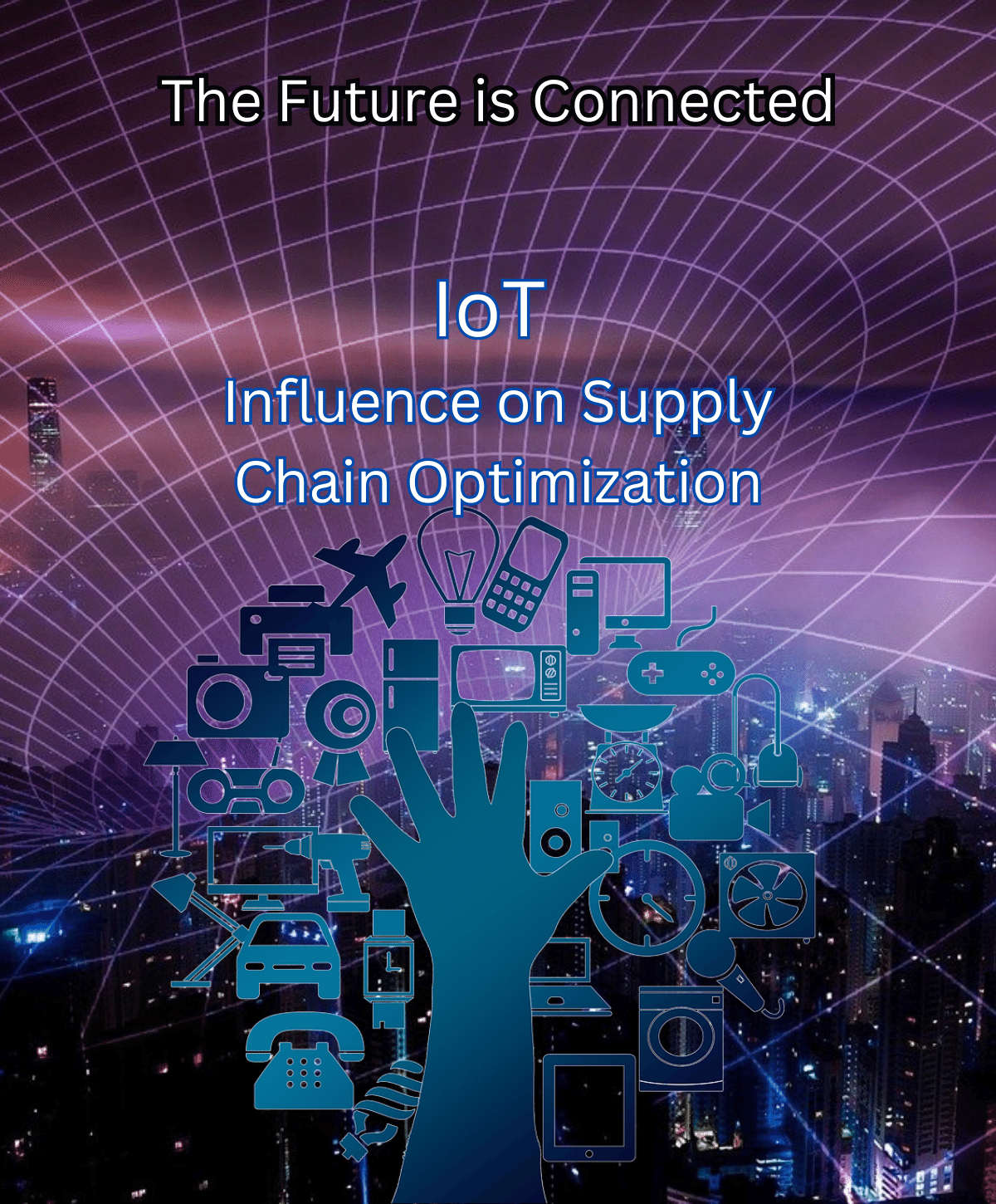Embrace the connected future as we delve into the profound impact of IoT on supply chain optimization and its potential for transformative growth.
Introduction
In today's fast-paced and interconnected world, businesses face the constant challenge of enhancing their supply chain efficiency and responsiveness. The Internet of Things (IoT) has emerged as a transformative technology, offering a wealth of opportunities to optimize supply chain operations and drive competitive advantage. By harnessing the power of connected devices and real-time data, organizations can gain unprecedented visibility, agility, and control over their supply chain networks. In this article, we will explore how the IoT is revolutionizing supply chain optimization, enabling businesses to streamline processes, improve decision-making, and deliver enhanced value to customers.
1. Understanding the Internet of Things (IoT)
Defining the IoT and its key components
The Internet of Things (IoT) refers to the network of physical objects embedded with sensors, software, and connectivity that enables them to collect and exchange data. These objects, also known as "smart" devices, can range from simple sensors and actuators to complex machinery and vehicles. They communicate with each other and with central systems, creating a vast ecosystem of interconnected devices.
To illustrate, imagine a fleet of delivery trucks equipped with GPS trackers, temperature sensors, and RFID tags. These devices can collect data on the location, temperature, and condition of the goods being transported. This data is then transmitted in real time to a central monitoring system, allowing stakeholders to track the status of shipments and make informed decisions.
Exploring the potential of IoT in various industries
The IoT has immense potential across industries, including manufacturing, retail, healthcare, and transportation. In the context of supply chain optimization, the IoT offers unprecedented opportunities to streamline operations, reduce costs, and enhance customer satisfaction.
For example, in the manufacturing sector, IoT-enabled sensors can monitor machine performance, detect anomalies, and trigger maintenance actions automatically. This proactive approach minimizes unplanned downtime and maximizes production efficiency.
2. The Role of IoT in Supply Chain Optimization
Enhancing visibility and transparency
One of the key benefits of IoT in supply chain optimization is the ability to gain real-time visibility and transparency across the entire supply chain network. By connecting devices and assets, organizations can track and monitor their inventory, shipments, and production processes in real time. This visibility enables proactive decision-making, reducing delays, minimizing stockouts, and optimizing resource allocation.
Furthermore, IoT sensors can capture data on environmental conditions, such as temperature, humidity, and light exposure. This information is invaluable in industries like pharmaceuticals and food, where strict quality control is necessary. By continuously monitoring environmental factors, businesses can ensure compliance, prevent spoilage, and maintain product integrity.
Enabling predictive maintenance and asset tracking
IoT devices embedded in machinery and equipment can collect data on performance metrics, such as temperature, vibration, and energy consumption. This data enables predictive maintenance, where anomalies and potential failures can be detected early. By addressing maintenance issues proactively, organizations can prevent costly breakdowns, extend the lifespan of assets, and optimize maintenance schedules.
Moreover, IoT-powered asset tracking solutions provide real-time information on the location and status of goods in transit. By leveraging technologies like GPS and RFID, organizations can track shipments, optimize routes, and respond to disruptions effectively. This level of visibility enhances supply chain efficiency, reduces theft and loss, and improves overall customer satisfaction.
Improving inventory management and demand forecasting
Accurate inventory management and demand forecasting are critical for optimizing supply chain operations. IoT devices play a crucial role in providing real-time data on inventory levels, usage patterns, and customer demand. This data enables organizations to optimize inventory levels, reduce carrying costs, and prevent stockouts or overstocks.
Additionally, IoT sensors integrated with point-of-sale systems can capture real-time sales data. By analyzing this data in combination with external factors like weather patterns and promotional activities, businesses can enhance their demand forecasting accuracy. This allows for better inventory planning, efficient production scheduling, and improved customer service levels.
3. Real-Time Data and Analytics
Harnessing the power of real-time data
The IoT generates a massive volume of real-time data that holds significant potential for supply chain optimization. However, the true value lies in the ability to collect, process, and analyze this data effectively. Advanced data collection and integration systems are crucial for capturing data from diverse sources and ensuring its quality and reliability.
Cloud-based platforms and edge computing technologies are commonly used to process and store IoT data. These technologies enable real-time data analytics, allowing organizations to extract actionable insights promptly. By leveraging real-time data, businesses can identify bottlenecks, optimize processes, and make data-driven decisions to enhance overall supply chain performance.
Leveraging advanced analytics for actionable insights
The integration of IoT-generated data with advanced analytics techniques, such as machine learning and artificial intelligence, unlocks a new level of supply chain optimization. These analytics algorithms can uncover hidden patterns, detect anomalies, and generate predictive models that support decision-making.
For instance, machine learning algorithms can analyze historical data to identify patterns in customer demand and anticipate future trends. This information enables businesses to adjust production schedules, optimize inventory levels, and allocate resources efficiently. Similarly, predictive analytics can forecast maintenance requirements, enabling organizations to plan proactive maintenance activities and reduce downtime.
4. IoT-enabled Supply Chain Use Cases
Smart warehousing and inventory control
IoT technologies have revolutionized warehousing and inventory control by providing real-time visibility and automation capabilities. RFID tags and sensors can track the location, movement, and condition of inventory items within a warehouse. This information can be integrated with inventory management systems, enabling real-time inventory tracking, efficient stock replenishment, and accurate order fulfillment.
Smart technologies, such as automated picking systems and robotics, can be seamlessly integrated with IoT devices to optimize warehouse operations. These technologies enable faster order processing, minimize errors, and increase overall operational efficiency.
Intelligent transportation and logistics
The IoT plays a crucial role in optimizing transportation and logistics within the supply chain. Connected devices, including GPS trackers, telematics sensors, and route optimization software, enable organizations to track and manage the movement of goods in real time. This ensures timely deliveries, minimizes transportation costs and improves route efficiency.
Furthermore, IoT-enabled sensors can monitor the condition of goods during transportation, such as temperature-sensitive pharmaceuticals or perishable food items. Any deviations from the optimal conditions can trigger alerts, allowing immediate corrective actions to maintain product quality and integrity.
Optimizing production and manufacturing processes
IoT technologies offer significant opportunities for optimizing production and manufacturing processes. By connecting machines, equipment, and sensors, organizations can gather real-time data on production performance, energy consumption, and equipment health. This data enables proactive maintenance, process optimization, and predictive quality control.
Additionally, IoT devices can facilitate seamless communication and collaboration between different stages of the production process. For example, data collected from production lines can be shared with suppliers and distributors, allowing for better coordination and improved responsiveness to demand fluctuations.
5. Overcoming Challenges in IoT Implementation
Security and privacy concerns
As with any technology that involves data exchange, security, and privacy concerns are paramount in IoT implementation. With a multitude of connected devices and data points, ensuring the confidentiality, integrity, and availability of data becomes a significant challenge. Organizations must implement robust security measures, including encryption protocols, access controls, and secure communication channels, to protect IoT systems from cyber threats.
Furthermore, privacy considerations must be addressed to protect the sensitive information collected by IoT devices. Compliance with data protection regulations and transparent data handling
6. Case Studies: IoT Success Stories in Supply Chain Optimization
Walmart's use of IoT to improve food quality, lower energy consumption and keep costs low for our customers
Walmart, one of the world's largest retailers, has leveraged IoT technologies to revolutionize its food quality and cost control. As part of our digital transformation, the company uses the Internet of Things (IoT) at a scale unmatched across retail to improve food quality, lower energy consumption and keep costs low for our customers. Currently, Walmart manages more than 7 million unique IoT data points across our U.S. stores. Every day, this network of connected devices sends almost 1.5 billion messages regarding temperature, operating functions, and energy use. To help manage this massive volume, the IoT team within Walmart Global Tech has built proprietary software that uses advanced algorithms to detect anomalous events in real-time and take action to fix issues quickly. By implementing IoT-enabled temperature and energy use systems, Walmart has significantly improved its operational efficiency and customer satisfaction. Link to the case study.
Maersk Line's smart container tracking system
Maersk Line, a global leader in shipping and logistics, has embraced IoT to enhance its container tracking capabilities. By embedding IoT sensors in containers, Maersk Line can track their location, temperature, and humidity during transit. This real-time information enables proactive decision-making, such as rerouting shipments to avoid delays or addressing temperature deviations promptly. Maersk Line's IoT-enabled container tracking system has improved supply chain visibility, minimized losses, and ensured the integrity of sensitive cargo.
Today, Maersk has more than 300,000 “smart” containers that transmit relevant vital signs (location, power supply, internal temperature) to Maersk’s cloud where they can be analyzed in real-time at the company’s headquarters. Maersk has continued to embrace IoT by developing cargo care software that monitors and adjusts the internal climate of refrigerated cargo containers in real-time. Maersk refers to this technology as the “remote container management” (RCM) system. This system has three core components, a 3G Sim which can operate at high temperatures, an antenna to transmit data to the cloud, and a GPS unit to ensure accurate and real-time location tracking Link to the case study.
7. The Future of IoT in Supply Chain Optimization
Emerging trends and technologies
The future of IoT in supply chain optimization holds exciting possibilities. Some emerging trends and technologies include:
- Edge computing: Moving data processing closer to the source, reducing latency, and enabling faster decision-making.
- 5G connectivity: Providing higher bandwidth and lower latency, enabling seamless communication and supporting more IoT devices in the supply chain network.
- Blockchain: Enhancing transparency, traceability, and trust in supply chain operations by securely recording and verifying transactions.
Predictions for IoT's Impact on the supply chain landscape
The impact of IoT on the supply chain landscape is expected to grow exponentially. Predictions include:
- Increased automation: IoT-enabled devices and robotics will automate various aspects of supply chain operations, from warehousing to transportation.
- Enhanced predictive analytics: Advanced analytics algorithms will leverage IoT data to provide more accurate demand forecasting, predictive maintenance, and proactive decision-making.
- Collaborative ecosystems: IoT will enable closer collaboration between supply chain partners, fostering seamless integration and end-to-end visibility.
In conclusion, the Internet of Things (IoT) is revolutionizing supply chain optimization by providing real-time visibility, predictive insights, and automation capabilities. From smart warehousing to intelligent transportation, IoT-enabled solutions are transforming traditional supply chain processes and driving efficiency gains. While challenges such as security and privacy exist, organizations that successfully implement IoT technologies can gain a competitive edge, improve customer satisfaction, and navigate the complexities of the modern supply chain landscape.
References:
- Walmart's Use of IoT: How Walmart Leverages IoT to Keep Your Ice Cream Frozen(Walmart Newsroom)
- Maersk Line's Smart Container Tracking: The Internet of Things and Maersk’s Gains from Digitization (Harvard University)
- Maersk Digital Solution



